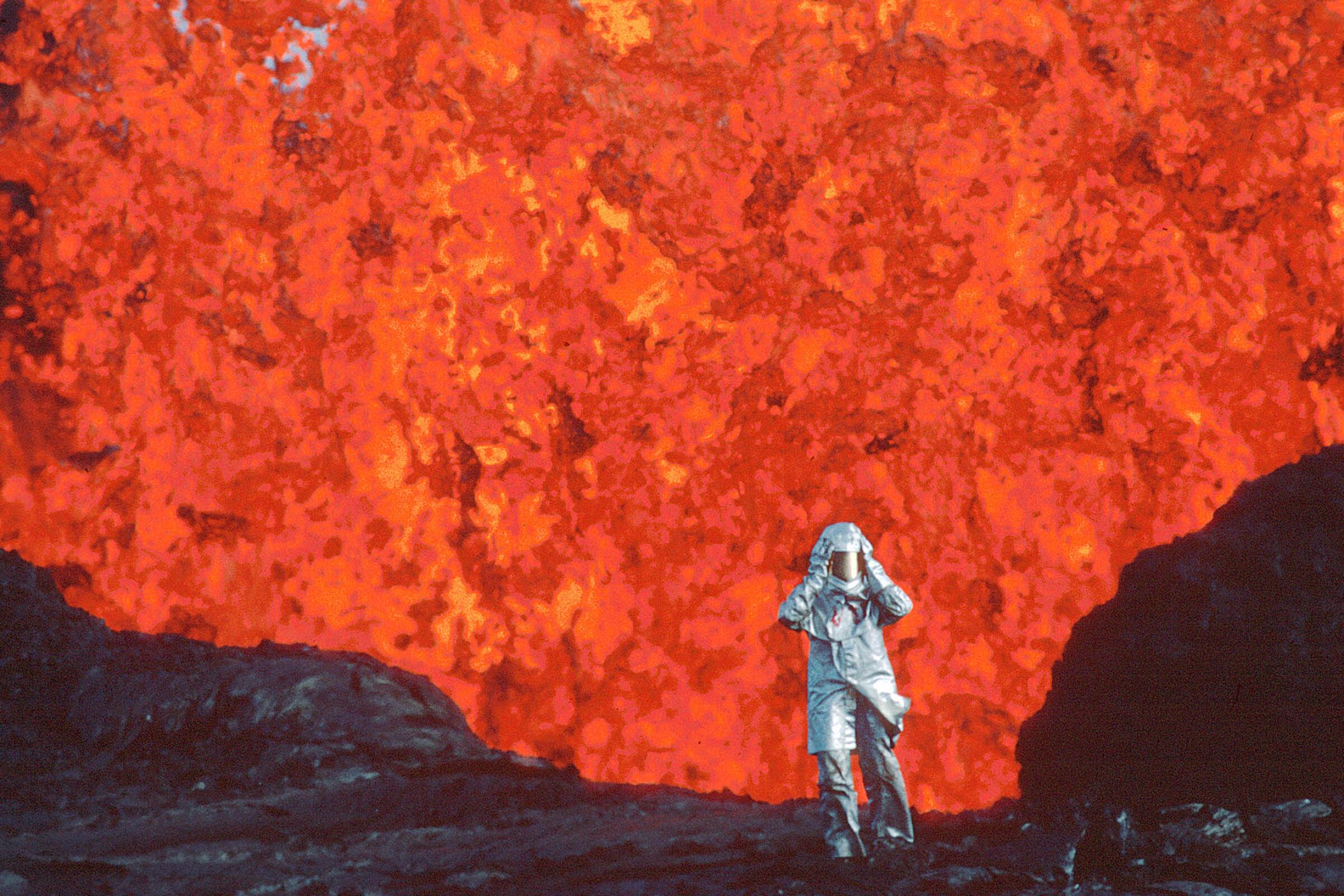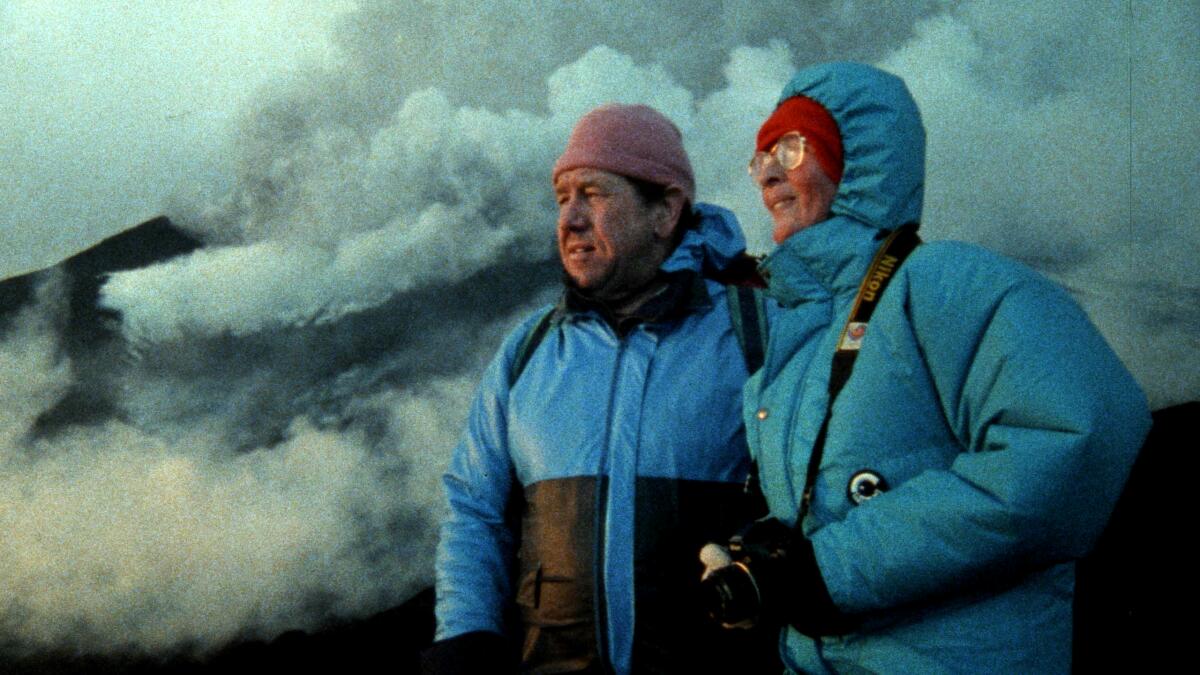Newsletter
Only good movies
Get the Indie Focus newsletter, Mark Olsen's weekly guide to the world of cinema.
You may occasionally receive promotional content from the Los Angeles Times.

Sweltering lava flows through the astonishing footage in “Fire of Love,” a blazingly lyrical documentary that equally considers an indomitable force of nature and the incomprehensible manifestations of human affection.
The couple responsible for the film’s entrancing reels of explosions and rivers of molten rock — collected over decades of expeditions to active volcanos around the globe — are French volcanologists Katia and Maurice Krafft. After their untimely deaths in 1991 near Mt. Unzen in Japan, the pair left behind material immortalizing both their shared fascination with the earth’s cataclysmic power and the intensity of their bond. Their vocation for volcanos verged on veneration.
Director Sara Dosa’s romantic nonfiction feature, which premiered at this year’s Sundance Film Festival and is now playing in limited release, has been built almost entirely from the late scientists’ filmic and photographic recollections.
“They got up so close to these erupting craters and their sheer love is palpable in their imagery,” Dosa told The Times during a recent video interview from the Karlovy Vary International Film Festival. “They aren’t just gorgeous photos of volcanoes. I really believe you can sense their passion, their desire through the frame. “
Sara Dosa’s Sundance prize-winning film tells the story of French volcanologists Katia and Maurice Krafft using their own extraordinary footage.
“Fire of Love” traces the Kraffts’ ardent connection, from the conflicting accounts of their first meeting as University of Strasbourg students in the 1960s, to their numerous travels to inhospitable locations where Katia acted as the voice of reason while a mischievous Maurice put himself unnecessarily at risk.
Dosa illuminates the blurred divide between the two forces majeures that brought them together: a reciprocated amorous liaison and an almost irrational curiosity for the same hazardous subject matter.
The seasoned documentarian and producer first learned about the Kraffts while making her previous environmentally minded, Iceland-set project “The Seer and the Unseen,” about a woman with a spiritual connection to the natural world. While searching for footage of a local volcano, Dosa came across clips of Katia and Maurice online — it was enough to pique her creative interest.
“It was unmistakably different than other volcano footage that I’d seen,” she said. “But once we really learned about them as people that had this beautiful relationship with each other, as well as these idiosyncratic personalities and lifestyle with a philosophy towards how to live because they had to reconcile death from such an early age, that’s when we really felt they would make for amazing characters in a film.”

Intrigued, she put that idea in the back of her mind to pursue in the future. But after the COVID-19 global emergency forced Dosa’s team to abandon a planned project in Siberia, the story of Katia and Maurice, told in preexisting documentation, resurfaced as a possible avenue.
“We thought, ‘Maybe this could be the perfect project to make during the pandemic,’” she explained. “Not only because it’s archival, but in our minds, we thought it could be perhaps a form of transcendence to get to tell a story about fear, uncertainty, and how to navigate through the unknown during such a time of loss and struggle.”
By the time Dosa wanted to access the Kraffts’ staggering collection, it was held by French archival facility Image’Est. The organization spent several months digitizing the celluloid that hadn’t been previously scanned for the filmmakers to utilize. In total, the team amassed thousands of Katia’s photographs and 250 hours of footage — about 200 hours of 16-millimeter prints filmed by Katia and Maurice, plus an additional 50 hours of their television appearances obtained from the French National Archives with the help of researcher Nancy Marcotte.
While those on-camera interviews for variety shows or newscasts provided a glimpse into the married couple’s personalities and humor, they didn’t include discussions on the inner workings of their relationship. Neither did their daring feats captured in the field.
“There was no sync sound with the 16-millimeter footage and there’s very little imagery of the two of them together in what they shot because someone is usually behind the camera,” Dosa noted. “They also didn’t film their personal life. They wanted to just film volcanoes.”
To fill in the lack of overt intimacy, Dosa and her collaborators had to explore other storytelling devices. The answer was in the couple’s nearly 20 published books.
Infused with emotional language, the narration in Katia and Maurice’s writing reminded Dosa of the playful and bombastic voice-over in some of François Truffaut’s films and the French New Wave in general — a movement that occurred during the Kraffts’ youth.

“We felt like it could be appropriate to channel their own artistic impulses in the making of our film. That’s why narration seemed like it could work. But we wanted a narrator that was curious and inquisitive to call out some of the unknowns, the gaps in the archive, rather than claim to possess all knowledge,” she said.
Framing their poetic epic as a romantic dilemma between Katia, Maurice and the many volcanoes they were infatuated with also came from the volcanologists’ own words.
“We got the idea of the love triangle from a sentence in a book that Maurice wrote where he says, ‘For me, Katia and volcanoes, it is a love story.’ That now is a line at the very end of our film, but for us it was a genesis point,” said Dosa. “We thought, ‘This is our thesis. It’s these three characters. Two of them are in love with each other and this other force.’”
Co-writing with producer Shane Boris and two editors, Erin Casper and Jocelyne Chaput, Dosa put together the stirring text that would guide the audience into her subjects’ magma-covered universe. At first, the creators considered having a French narrator, but during a brainstorming session the name of filmmaker and actress Miranda July (“Me and You and Everyone We Know”) came up as an option.
The Times team shines a spotlight on select titles from the 2022 Sundance Film Festival, including personal favorites and titles emblematic of this year’s virtual gathering.
“We thought Miranda would be perfect not just because she is such a curious observer of the human condition herself, but so much of her work deals with the strange beauty of what it means to not just be alive but also our relationships with each other,” said Dosa.
Before meeting Dosa, July watched a short segment of “Fire of Love” that stunned her on a profound level. “I had a weirdly emotional response to it. I felt tearful and out of breath just watching this little piece,” July said by phone.
Upon meeting Dosa over Zoom, July realized it wasn’t only Katia and Maurice’s journey that moved her but the delivery of their story in this director’s hands.
“I discovered the source of the feeling that I was having, which was this person who was leaning into the emotionality — the hot liquid side of that material — in a way that was easy for me to connect to,” July noted. “I could see how my voice might be useful.”
“She brought such richness and vulnerability and strength and curiosity as she did her delivery,” Dosa said of July.
In turn, working with Dosa reminded July of her own artistic impulses. After having recorded her part for several days, July thought she was done, until eventually Dosa called her back to redo certain sections. As an example of what she was looking to achieve, Dosa played July a momentous scene with her voice cut in. It blew her away.
“Without trying to sound arrogant, I was surprised and got tingles from it,” July recalled. “Sara said, ‘That’s what I want for the whole movie, and I have the parts that we need to redo.’ Now everyone in the room was on the same page.”

For the audience to fully experience the visuals, Dosa believed the narration and the editing had to exist in harmony. One of their mandates was to use volcanoes as an illustration of Katia and Maurice’s love language and the trajectory of their union: “Sparks would fly at the beginning, then lava would bubble and boil, and we would culminate with greater explosions as they were dreamily falling in love.”
And while they conducted interviews with about 15 people who knew the couple, the filmmakers ultimately chose to fold their anecdotes into the narration rather than include talking-head portions that would disrupt the perspective focused on the protagonists.
The director also embraced a geologic methodology in her filmmaking: a willing acceptance that not every question would get an answer, and that there’s beauty in the unknown.
“Geologists such as Katia and Maurice survey the clues left behind through earth processes to try to tell a story about creation through a scientific language,” Dosa explained. “We wanted to take these clues, these pieces of life that they left behind, their own imprints of their life processes, and interpret them through research as if we were scientists trying to understand them to the best of our ability. And then tell a story about both what we knew and also hint at what we didn’t know, and what would always be unrequited in our search.”
For July, the footage the Kraffts left as their legacy was ripe for cinematic interpretation. “They were filmmakers and not entirely scientific filmmakers,” said July. “They were shooting footage that would work well for a narrative. You don’t shoot like that unless you think it’s going to cut together. What we are doing here is really fulfilling their vision.”
Only good movies
Get the Indie Focus newsletter, Mark Olsen's weekly guide to the world of cinema.
You may occasionally receive promotional content from the Los Angeles Times.